WebHelp:Adding Existing Files to the Library/5.0: Difference between revisions
mNo edit summary |
mNo edit summary |
||
| Line 24: | Line 24: | ||
*''Scan file directories for Artwork'' will associated external Artwork with the files being scanned. For this to work you should have the files separated in Album folders with the Artwork files in the same folder. If you have a messy organization for your files it's recommended to disable this. | *''Scan file directories for Artwork'' will associated external Artwork with the files being scanned. For this to work you should have the files separated in Album folders with the Artwork files in the same folder. If you have a messy organization for your files it's recommended to disable this. | ||
*''Generate video thumbnails'', MediaMonkey can create a video thumbnail to display as Artwork for videos. | *''Generate video thumbnails'', MediaMonkey can create a video thumbnail to display as Artwork for videos. | ||
== Manually Scanning Files into the Library == | == Manually Scanning Files into the Library == | ||
| Line 65: | Line 66: | ||
In addition to updating the library for added/changed Media Files, this will: | In addition to updating the library for added/changed Media Files, this will: | ||
*Automatically remove any Media Files that have been deleted (enable/disable under '''Tools > Options > Library''' on the main menu with the | *Automatically remove any Media Files that have been deleted (enable/disable under '''Tools > Options > Library''' on the main menu with the ''Remove unavailable items'' option.) | ||
*Automatically change the location of any Media Files that have been moved. | *Automatically change the location of any Media Files that have been moved. | ||
If you're planning to move files outside of MediaMonkey either manually in File Explorer or by using another application you should set the Schedule to the '''Continuously''' option on both the source and destination folder and leave MediaMonkey running while you're making the changes. This way the MediaMonkey Library remains up to date with the new file locations. However you should check out the [[{{WebHelp:Links|Changing_Filenames}}|built in methods for moving files]] as there are automated tools to do so. | |||
== Manually Adding Individual Media Files == | == Manually Adding Individual Media Files == | ||
You can manually add individual Media Files to the Library without having to rescan folders by: | You can manually add individual Media Files to the Library without having to rescan folders by: | ||
*Dragging & dropping them on the main [[WebHelp:Playback Rules | *Dragging & dropping them on the main [[{{WebHelp:Links|Playback Rules}}#Collections|Collection]] nodes in the Media Tree from File Explorer ''(You can't D&D files onto any sub-nodes or other nodes in the Media Tree).'' | ||
*Dragging & dropping them into the [[WebHelp:Now Playing | *Dragging & dropping them into the [[{{WebHelp:Links|Now Playing}}|Playing]] and from the [[{{WebHelp:Links|Now Playing}}|Playing]] dragging & dropping them onto a [[{{WebHelp:Links|Using Playlists}}|Playlists]] ''(not [[{{WebHelp:Links|Using AutoPlaylists}}|AutoPlaylists]]).'' | ||
Revision as of 21:55, 8 December 2020
Wiki Home > MediaMonkey 5 Help > Adding Media Files & CDs > Adding Existing Files to the Library
Adding Media Files to the MediaMonkey Library allows you to create Playlists and AutoPlaylists, Sync and Stream to other devices, as well as keep track of play counts. You can access Media Files not in the Library through the Folders node in the Media Tree, but play counts won't be remembered for this node.
Setup how MediaMonkey Scans Files
Go to Tools > Options > Library to set how MediaMonkey scans for your files or use the Options button in the Add/Rescan Files dialog. It's recommended to do this before the first scan.
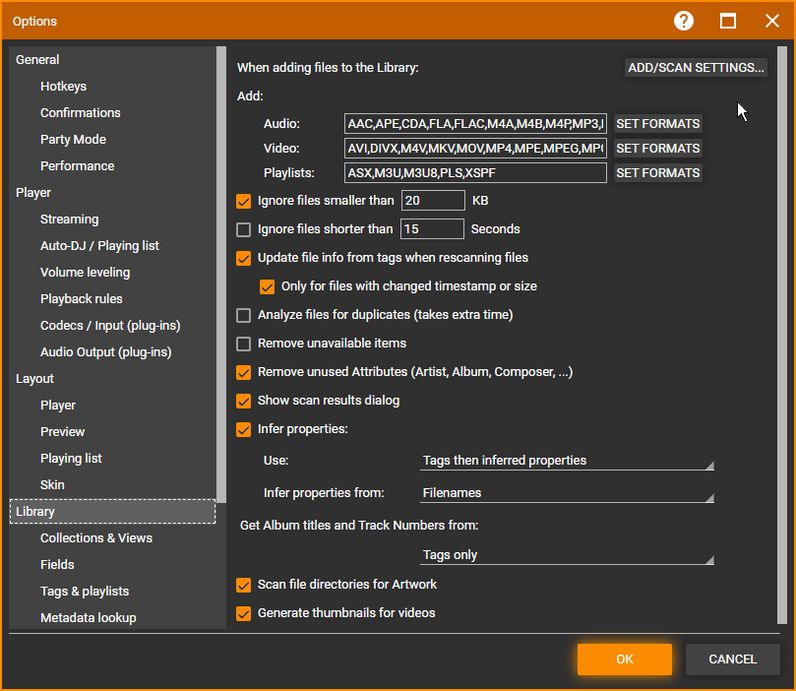
- Choose which File Types for Audio, Video and Playlists MediaMonkey is allowed to add to the Library when adding files.
- Choose to not add files that are shorter than a user defined KB or Seconds with Ignore Files.
- Set whether MediaMonkey should update tags of files already in the Library when they're scanned again. Enable Update file info from tags when scanning files to enable this. In most cases this will work with the option Only for files with changed timestamp or size enabled as well, which would skip this for files that haven't been changed.
- Analyze files for duplicates is needed to manage duplicates.
- Remove unavailable items will remove any files in the scanned folders that are in the MediaMonkey Library, but no longer reside in that location.
- Remove unused Attributes will remove any tag values from the database that are no longer used by any files in your MediaMonkey Library.
- Show scan results dialog will show you the results of the scan once the scan completes.
- Infer properties will try to guess tags from folder/filenames. This can be useful when tags are missing from the files. This is an automatic process and may give the wrong results, you can use Auto-Tag from Filename instead as it gives manual control.
- Get Album titles and Track Numbers from allows you to use Playlists (if included in the scan) to get the Album and Track# information. This information is usually in the tags already for most files.
- Scan file directories for Artwork will associated external Artwork with the files being scanned. For this to work you should have the files separated in Album folders with the Artwork files in the same folder. If you have a messy organization for your files it's recommended to disable this.
- Generate video thumbnails, MediaMonkey can create a video thumbnail to display as Artwork for videos.
Manually Scanning Files into the Library
To manage your Media Files, you'll want to add them to the Library. This will index you files whether they're on your internal, external or networked storage. MediaMonkey does not move your files when you scan them into the Mediamonkey Library (unless you enable Auto-Organize). Scanning is offered the first time the application is run. Subsequently, you can initiate this process manually:
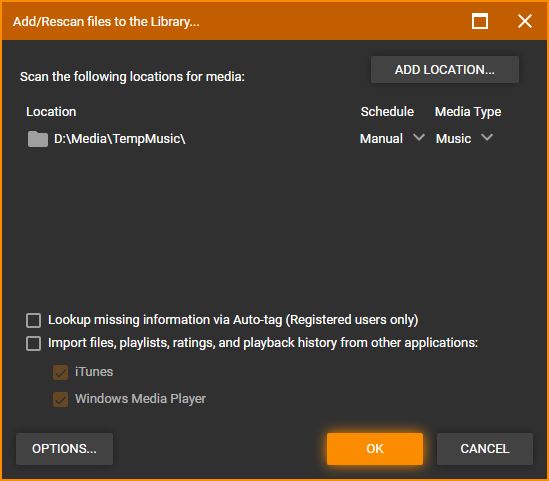
- Select File > Add/Rescan files to the Library from the Main Menu, or press <Insert>.
- Use Add Location to select a Drive or Folder (from Local Storage), Network Location, Media Server or Cloud Storage you wish to add.
- Use the Options button to change the options affecting scanning of files.
- For each Location selected for scanning you can define what Type the files in that Location should be assigned. If set to Auto detection MediaMonkey will automatically assign Type. MediaMonkey uses Type to filter files into the default Collections like Music, Classical Music or Videos. All files are visible in the Entire Library) Collection.
Once you press the OK button, MediaMonkey will scan the selected locations for the types of Media Files that you chose, and depending on your settings:
- Add any newly found Media Files and associated Art (from files or tags) to the Library.
- Catalog the contents of any CDs that are selected to be scanned to the Library. CDs that have been added to the Library will appear in the Location node of the matching Collection. If any CD is selected to be scanned, the Files on the CD will appear greyed out if the CD is not inserted, and in black if the CD is inserted.
- Add any .m3u Playlists that are found to the Library under the Playlists > Imported Playlists in the Media Tree, along with any of the Media Files contained within the Playlists (if they can be found in the path stored in the M3U file). Playlists are text files with Paths to the Media Files on the Playlists. Any files that aren't found in the Paths on the Playlist will not be added to the Playlist in MediaMonkey. Any Text Editor (like Notepad) can be used to view and modify the Paths on Playlist files prior to scanning them.
- Notify you of any Media Files that are missing from the scanned location if enabled to check and give you the option to remove them from the Library or find them using Locate Moved/Missing files.
- Update the properties of any scanned media files that have changed (configurable, by default, only files whose file size or timestamps has changed are updated).
- Give you the option of importing missing ratings, play count, and last played data associated with the media files from a Windows Media Player, iTunes or Winamp database, if one resides on your computer.
- Give you the results of the scan. The Scan Results can be enabled/disabled under Tools > Options > Confirmations from the Main Menu.
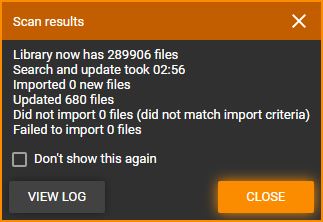
MediaMonkey Scan Results
Using Folder Monitoring to Automatically Update the Library
The Add/Rescan files to the Library dialog also allows you to monitor selected folders for any changes to Media Files so that the library is automatically updated. To do so change the Schedule setting for a Location set for scanning.
- Select Continuously for any Location to update the Library if changes occur in that Location while MediaMonkey is running.
- Select At startup for any Location to check for changes and update the Library at the start of MediaMonkey for changes that occurred while MediaMonkey wasn't running.
- Select At Startup & Continuously if you want both to happen for that Location.
- Setting Schedule back to Manual will stop Folder Monitoring for that Location. You can also Delete the Location to remove it from Folder Monitoring.
In addition to updating the library for added/changed Media Files, this will:
- Automatically remove any Media Files that have been deleted (enable/disable under Tools > Options > Library on the main menu with the Remove unavailable items option.)
- Automatically change the location of any Media Files that have been moved.
If you're planning to move files outside of MediaMonkey either manually in File Explorer or by using another application you should set the Schedule to the Continuously option on both the source and destination folder and leave MediaMonkey running while you're making the changes. This way the MediaMonkey Library remains up to date with the new file locations. However you should check out the built in methods for moving files as there are automated tools to do so.
Manually Adding Individual Media Files
You can manually add individual Media Files to the Library without having to rescan folders by:
- Dragging & dropping them on the main Collection nodes in the Media Tree from File Explorer (You can't D&D files onto any sub-nodes or other nodes in the Media Tree).
- Dragging & dropping them into the Playing and from the Playing dragging & dropping them onto a Playlists (not AutoPlaylists).
Manually Locate Moved/Missing Files
If Media Files have been moved by another application to a new location, MediaMonkey will automatically find the Media File when the File Monitor is configured to monitor the directory to which the media file has been moved. For other cases:
- Go to Collection > Files to Edit > Dead Links in the MediaMonkey Media Tree. You will see a list of Media Files that are inaccessible because they have either been moved or deleted.
- Select the Media File(s) you want to find, and select File > Locate Moved/Missing files on the main menu.
- Choose which drives you would like to scan for the Media File(s).
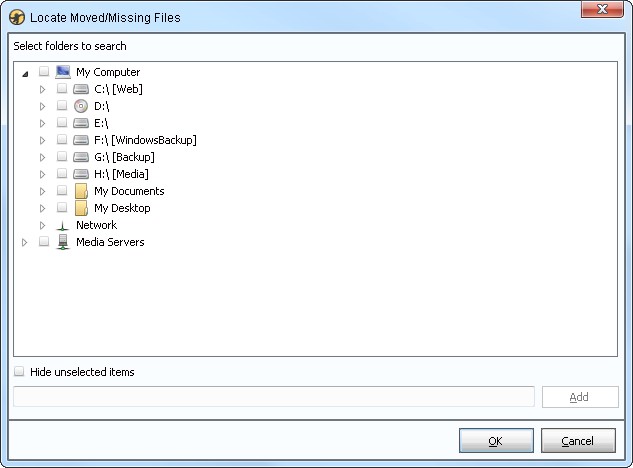
Locate Moved/Missing files dialog - A dialog will appear showing moved files that have been found, files that haven't been moved, and files that couldn't be found. Of those that have been found, select the check box next to them to confirm that you want to update the library with the location indicated.
- The Files Located in New Locations tab shows all files that were moved and have been found in a new location by Locate Moved/Missing Files. Enable Update selected files in the database if you want to update the paths on selected files in the database with the new locations found.
- The Unmoved files tab shows all files that are still accessible in the location stored in the Library.
- The Unlocatable files tab shows all files that were moved, but can't be found by MediaMonkey in the scanned locations. Enable Remove selected files from the database if you want to remove the selected files that couldn't be located from your Library.
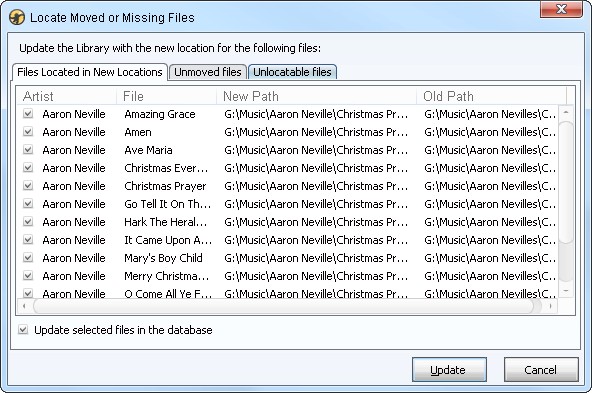
Notes
- If you wish to interrupt the file scanning process at any time, simply right-click on the status bar near the bottom of the screen, and click Terminate. If you wish to reduce the amount of CPU cycles used during the process, you may similarly right-click on the status bar, select Change Priority, and choose a lower priority level.
- Although the File Monitor does monitor for moved files, it only searches the specified directories for the moved file, and consequently will not detect the location of the moved file if it has been moved to an unmonitored directory. For these situations, you can use Locate Moved/Missing files.
- Locate Moved/Missing Files finds files based on Filesize and Timestamps or track metadata (Length, Artist, Album and Title).
- If you have Media Files located on drives A or B you'll need to remove the used drive letter(s) from IgnoreDriveLetters=AB in the MediaMonkey.ini[1] file (make sure MediaMonkey is closed when editing MediaMonkey.ini[2].)
- If you have music stored in network locations it is preferred that you use the UNC Path (\\PCName\MusicFolder) instead of using Mapped Drives.
- Did not import xx files (did not match import criteria) will show a count of all files found in the scanned folder not matching the enabled File Types. This includes non Media Files like Office documents and application files, but also all Media Files not enabled under File Types.
- Files located in the VirtualCD, Previews and UPnP Cache folder will not be imported. Move the files out of these folders or change these folders location in the Options.
- Hidden files will not be imported. You'll need to unhide the files for MediaMonkey to be able to import them.
- Files with a full Path of more than 248 characters (including drive letter and extension may fail to scan into the Library. Windows accepts file Paths longer than this, but doesn't support it until newer Windows 10 releases and thus it can cause problems. It's recommended to keep file Paths under 248 characters, otherwise you can run into to weird problems with the files.
- The File Types setting in the Add/Rescan files to the Library dialog selects which types of files should be added to the Library. The File Types under Tools > Options > OS Integration selects for which File Types MediaMonkey will be set as default program to open them with.
- Only dragging & dropping on the main Collection nodes will add files to the Library. This is because other nodes like Album are meant to tag the file and thus MediaMonkey protects against inadvertent tagging by disabling drag & drop from outside of MediaMonkey on those nodes.
- Files located on drives no longer connected will not be listed in the Dead Links node.
- Art stored as files is only added on scanning when only Media Files belonging to the same Album/Series are stored in the folder with the Art and the option to Scan file directories for Artwork is enabled under Tools > Options > Library.
- To add Media Files from UPnP Media Servers select the Media Server in the MediaMonkey Media Tree and select File > Add/Rescan files to the Library on the main menu, or press <Insert>.
- To re-enable the Import Data (from WMP and iTunes) dialog after scanning set ConfirmImportRatings to ConfirmImportRatings=1 in the MediaMonkey.ini[3] file (make sure MediaMonkey is closed when editing MediaMonkey.ini[4].)
- To re-enable the Scan Results dialog after scanning set ConfirmScanResults to ConfirmScanResults=1 in the MediaMonkey.ini[5] file (make sure MediaMonkey is closed when editing MediaMonkey.ini[6].)
- An Locate Moved/Missing Files alternative is the Update Location of Files in Database addon [7] or the DriveID addon [8].
Related Information
Previous: Installing MediaMonkey
Next: Browse the Library
| English |
Additional Help: Knowledge Base | Forum | MediaMonkey Support | MediaMonkey for Android Help | MediaMonkey 5 Help | MediaMonkey 4 Help